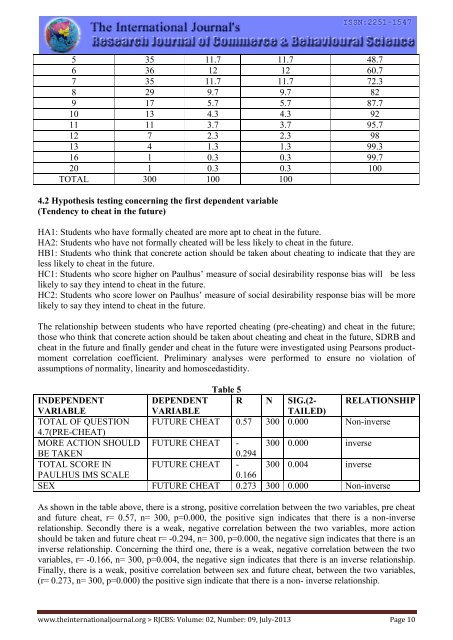Research Journal of Commerce & Behavioural Science - RJCBS
Research Journal of Commerce & Behavioural Science - RJCBS
Research Journal of Commerce & Behavioural Science - RJCBS
Create successful ePaper yourself
Turn your PDF publications into a flip-book with our unique Google optimized e-Paper software.
5 35 11.7 11.7 48.7<br />
6 36 12 12 60.7<br />
7 35 11.7 11.7 72.3<br />
8 29 9.7 9.7 82<br />
9 17 5.7 5.7 87.7<br />
10 13 4.3 4.3 92<br />
11 11 3.7 3.7 95.7<br />
12 7 2.3 2.3 98<br />
13 4 1.3 1.3 99.3<br />
16 1 0.3 0.3 99.7<br />
20 1 0.3 0.3 100<br />
TOTAL 300 100 100<br />
4.2 Hypothesis testing concerning the first dependent variable<br />
(Tendency to cheat in the future)<br />
HA1: Students who have formally cheated are more apt to cheat in the future.<br />
HA2: Students who have not formally cheated will be less likely to cheat in the future.<br />
HB1: Students who think that concrete action should be taken about cheating to indicate that they are<br />
less likely to cheat in the future.<br />
HC1: Students who score higher on Paulhus’ measure <strong>of</strong> social desirability response bias will be less<br />
likely to say they intend to cheat in the future.<br />
HC2: Students who score lower on Paulhus’ measure <strong>of</strong> social desirability response bias will be more<br />
likely to say they intend to cheat in the future.<br />
The relationship between students who have reported cheating (pre-cheating) and cheat in the future;<br />
those who think that concrete action should be taken about cheating and cheat in the future, SDRB and<br />
cheat in the future and finally gender and cheat in the future were investigated using Pearsons productmoment<br />
correlation coefficient. Preliminary analyses were performed to ensure no violation <strong>of</strong><br />
assumptions <strong>of</strong> normality, linearity and homoscedastidity.<br />
Table 5<br />
INDEPENDENT<br />
DEPENDENT R N SIG.(2- RELATIONSHIP<br />
VARIABLE<br />
VARIABLE<br />
TAILED)<br />
TOTAL OF QUESTION FUTURE CHEAT 0.57 300 0.000 Non-inverse<br />
4.7(PRE-CHEAT)<br />
MORE ACTION SHOULD FUTURE CHEAT - 300 0.000 inverse<br />
BE TAKEN<br />
0.294<br />
TOTAL SCORE IN FUTURE CHEAT - 300 0.004 inverse<br />
PAULHUS IMS SCALE<br />
0.166<br />
SEX FUTURE CHEAT 0.273 300 0.000 Non-inverse<br />
As shown in the table above, there is a strong, positive correlation between the two variables, pre cheat<br />
and future cheat, r= 0.57, n= 300, p=0.000, the positive sign indicates that there is a non-inverse<br />
relationship. Secondly there is a weak, negative correlation between the two variables, more action<br />
should be taken and future cheat r= -0.294, n= 300, p=0.000, the negative sign indicates that there is an<br />
inverse relationship. Concerning the third one, there is a weak, negative correlation between the two<br />
variables, r= -0.166, n= 300, p=0.004, the negative sign indicates that there is an inverse relationship.<br />
Finally, there is a weak, positive correlation between sex and future cheat, between the two variables,<br />
(r= 0.273, n= 300, p=0.000) the positive sign indicate that there is a non- inverse relationship.<br />
www.theinternationaljournal.org > <strong>RJCBS</strong>: Volume: 02, Number: 09, July-2013 Page 10

















